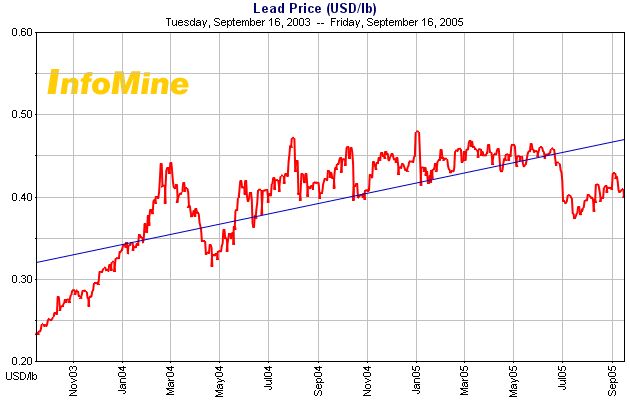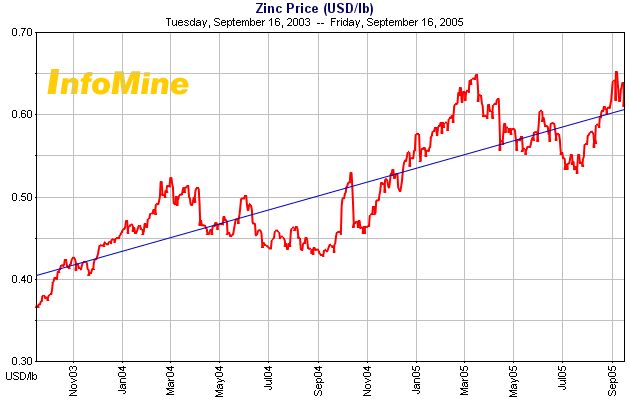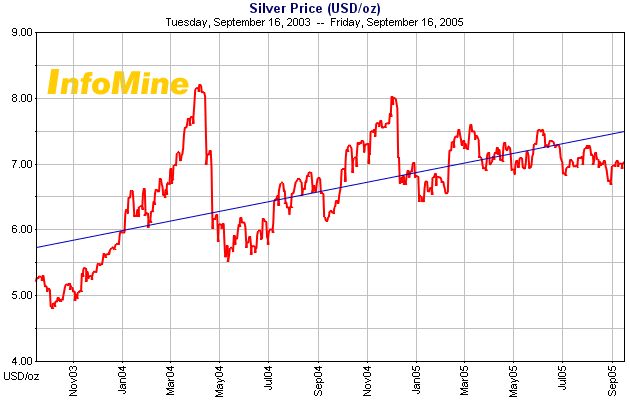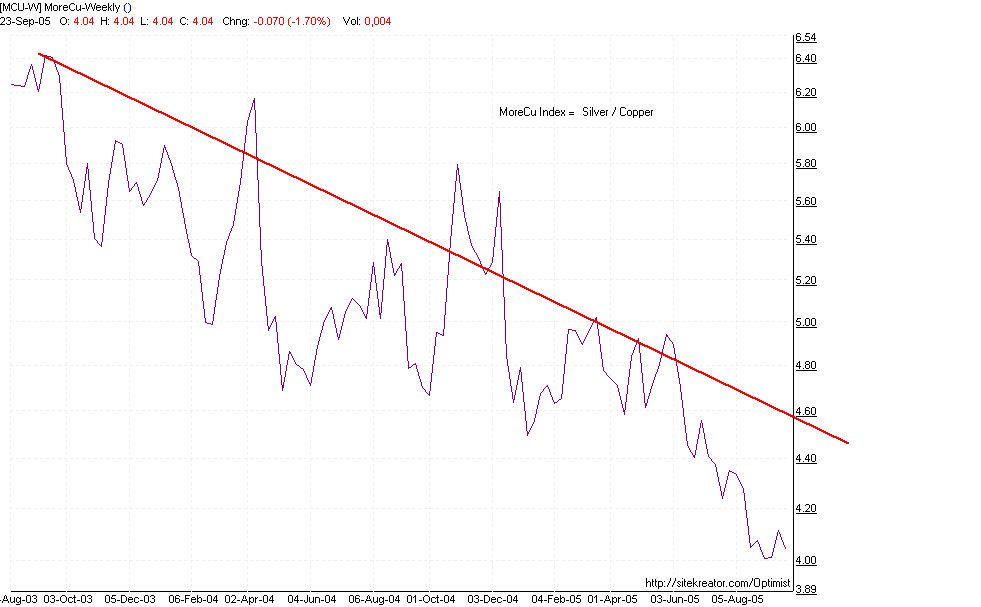When Will the Price of Silver Explode?
Published 9/17/05.
For all those readers who have slept through the last week, the Optimist is excited to tell you that the price of gold has surged to $460, its highest price in almost two decades. Speaking of sleeping, however, the price of silver has been disappointingly dull compared to gold. Although everyone knows that silver will more than double from its current price of $7.20, and will eventually multiply by a factor with one or more zeros (i.e., 10, or 100, or 1,000, etc.), the key question everyone asks is when the explosion will happen. It seems like most silver investors keep their bags packed for the rocket trip, but they want to wait to purchase the ticket until just before ignition and liftoff. The Optimist admits, of course, that his guesses about a date are no better than those of the readers, but he hopes to provide perspective for recognizing the ignition process so we can all enjoy the liftoff which will soon follow.
When there is a shortage of real physical silver
The Optimist must confess that he thought the rocket was ignited 18 months ago, and he briefly enjoyed illusions about what would be done with all the profits from the silver explosion. That sweet dream was rudely terminated by the subsequent market action, and the Optimist is now as cautious as everyone else about shouting that there are visible flames at the base of the silver rocket. In retrospect, it is now easy to see that throughout the rapid price increase in April 2004 there was adequate physical silver for continued manufacturing and for investment accumulation. That availability of real physical silver enabled the banks and the Comex paper printers to flood the market with paper silver and to drive the price lower. Note that the paper silver didn't actually create any real physical silver. It only saturated the investment demand for people who prefer to bet on the direction of silver prices than to hold physical silver in their possession. The key concept is that the paper silver operation would not have had any chance to drive the price of silver lower if there was not enough real physical silver available for consumption by manufacturers and for accumulation by some investors. The answer to when the price of silver will explode is when there are problems with industry and investors getting all the real physical silver that they need or want. No amount of pretend paper silver will make a real physical shortage go away.
So, when is that, exactly?
The next question readers will impatiently pose is exactly when will there be an unsatisfied physical silver demand. Readers will not be surprised with hearing yet another deficient answer. It isn't just that the Optimist doesn't know the date. If anyone did know the date when demand for real physical silver will overwhelm supply, they would be very unlikely to write about it on the Internet. They would instead be much too busy raising all the cash possible so they could purchase a maximum amount of real physical silver before that explosive date. The Optimist hopes, however, that he can provide a window on one of the key market dynamics that may help us to see when the ignition process is underway. Before opening that window, a little more background will be helpful.
The key is made of base metals
Readers are, no doubt, familiar with the ongoing silver supply-demand deficit, and with the portion of mining production that derives from base metals like copper, lead, and zinc. Approximately 60% of the amount of silver mined is a byproduct from these base metals. During times when more base metals are mined, the amount of byproduct silver which is dumped on the market as additional physical supply is proportionately increased. As one might guess from looking at a chart of energy prices, the world economy has been intensely hungry for energy, and for base metals. The rising prices of base metals over the past three years testify to the increasing worldwide demand for more base metals. It should be no surprise to any reader that rising prices of base metals cause mining companies to ramp up production to keep up with the demand (and to multiply their profits in the process). Consider the three charts (from InfoMine.Com) of lead, zinc and copper below, and you can be sure that base metal production has increased substantially in response to rapidly rising prices.



Silver shortage delayed
The increased production of base metals in response to rising prices resulted in significantly greater production of byproduct silver. Base metal miners don't care about managing the impact on the silver market, so they just dump that excess silver production into the market. The increased amount of byproduct silver meant that there was little risk of running out of real physical silver over the last three years, so the banks and the Comex creators of paper silver shorts could proceed without concern about being tripped up by the physical market. By comparing the three charts above to the comparable chart of silver below, it is easy to see that the rapidly rising base metals prices have had a constrictive impact on the price of silver.

It looks like the sharp increases of zinc and copper prices from May to September have contributed to the recent silver price doldrums even as gold has thrust into new highs for this move.
Introducing the MoreCu Index
Another way to view the relationship between silver and base metal prices is through a ratio. Everyone is familiar with the gold to silver ratio, even if silver bulls continue to be depressed by the faster price escalation of gold. Since silver is frequently thought of as more of an industrial metal rather than as a precious metal, another useful ratio is the price of silver divided by the price of copper. The Optimist calls this the MoreCu Index, because it shows more about the impact of copper and base metals on the price of silver. The rational for viewing this index as significant is that when base metal prices are rising rapidly due to industrial demand for base metals, then the additional byproduct silver produced will cause the price of silver to fall in relation to the base metals. If the price rises were due primarily to inflation, then one would expect the inflationary effects to be comparable to both base metals and to silver, so the ratio would be relatively little changed. Let's take a look at the Optimist's chart of the MoreCu Index:
The chart above is updated each week at this link:  Updated MoreCu Index
Updated MoreCu Index
Although silver gained strength briefly in the major run up in April 2004, it quickly surrendered those gains relative to the increase in copper prices. The sharp drop in this chart from May to September of this year is a strong testament to the strength of base metal prices, and is clear evidence that additional byproduct silver was supplied to the market in recent months.
So what does the MoreCu Index tell us?
The Optimist concludes that the very strong performance of base metals, and the substantial increase in byproduct silver mined, makes it unlikely that the price of silver will explode in the next month or two. Silver can increase in price toward $10 or $15 per ounce this year, of course, just on the strength of its own fundamentals and on the continuing deficit in production. For so long as base metals are white hot, however, the additional byproduct silver dumped into the market will enable the usual suspects to moderate the price rises and delay the explosion. As soon as a slowing worldwide economy reduces demand for base metals and results in a slowdown in base metal mining output, however, the byproduct supply source of additional silver will be removed, and that will open a window of potential price explosion. The MoreCu Index will show the changes in the relative strength between silver and copper. As silver shows sustained gains relative to copper, the fuse for ignition may well be lit.
Could the time be soon?
For those silver aficionados who want a more positive outlook for a quick silver price explosion, the Optimist can offer tantalizing possibilities to consider. Looking back at the chart of lead, one can see a broad topping pattern, with a sharp drop in June. Zinc looks like it could be falling away from a double top. Although copper continued to show impressive strength until last month, the drop in recent weeks could be the start of a major trend change. Ultra high energy prices are slowing the worldwide economy, and that slowdown will be reflected in reduced demands for base metals. If copper and the other base metal prices follow through to the downside here, the quantity of base metals mined will be sharply reduced and there will be a significant reduction in the amount of byproduct silver dumped into the market. Since there is no obvious alternative source of additional supply at a time when investment demand for silver is strongly increasing, cautious silver bulls might want to consider purchasing all their tickets for the silver rocket liftoff sooner instead of later!
Addendum (9/19/05)
For this commentary, the optimist assumed that base metal miners would have responded to higher prices by ramping up their production levels. In response to helpful advice, however, the Optimist did a little more research into the worldwide production levels for copper. The table below (reproduced from www.dailyfutures.com/metals/) as an example, indicates that world copper production was essentially flat for 2001 through 2003, but at much higher levels than in the early 1990s. In 2004, worldwide copper production increased by an estimated 6%, and then increased in 2005 by another estimated 6%.

If the annual silver production was on the order of 600 million ounces in 2003, and if 30 % of that silver production was a byproduct from copper mining, then copper mining produced approximately 180 million ounces of silver in 2003. The data above indicates that the amount of copper mined worldwide increased 12% since 2003. That implies that greater rates of copper production in response to higher copper prices have increased the rate of byproduct silver production to more than 200 million ounces of silver per year now. That is an increase of 20 million ounces which were pushed into the silver market this year due to the increased amount of byproduct from copper mining alone. Lead, zinc, and other metal mining interests have similarly increased production in response to higher base metal prices, so it is reasonable to guess that higher levels of base metal mining are now dumping approximately 3 million more ounces of silver each month than was the case two years ago. To paraphrase a U.S. Senator, a million ounces here and a million ounces there, month after month, begins to add significant supply to the silver market. While some pessimists complain that silver has not done better in comparison to gold, the Optimist is excited that silver prices have held up as well as they have in the face of increased supply.
Imagine what the price of silver might have accomplished without the additional supply provided by dumping greater amounts of byproduct silver into the market. Recent reports of increasing warehouse stock levels of copper and other base metals mean that we may not need to only imagine that prospect much longer. If base metal warehouse stocks continue to climb, the copper, lead, and zinc miners will be forced to reduce their level of base metal output to prevent a complete price collapse. Lower levels of base metal mining translate to less byproduct silver being delivered to the market. Meanwhile, investor excitement with precious metals continues to climb, and that translates to ever increasing demand for silver. Reduced supply coupled with increasing demand is the fuel for the great silver price rocket. A shortage in availability of physical silver available to the many competing interests who need or want it will be the source of ignition.
Even though paper silver contracts and certificates can be produced in unlimited quantities, that paper represents only promises, and many of those will be defaulted on. The Optimist cautions that you will need real physical silver to ride in the great silver price rocket. The more you have, the better the ride. Now is the first day of the rest of your limited time to acquire real physical silver!
* * * Notice * * *
This commentary presents only the viewpoints of the Optimist, and it is intended only for perspective and entertainment. Please do not interpret any portion of this work as investment advice. If any of the concepts discussed here appeal to you, then you must do the work to decide if and when and how you should invest. The Optimist does not ask for any profits you make, and he cannot be liable for any losses incurred as a result of your investment decisions. The Optimist wishes you the best of luck in whatever you decide to do or not to do. Cheers!
Reader contributions are welcome, and
excerpts will be added to this presentation.
Please send comments or suggestions to the Optimist:
Email:
